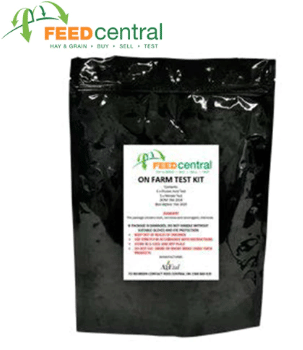Nitrate & Prussic Acid Testing Kit
Nitrate and Prussic Acid occur naturally in plants, but if plants are damaged or stressed, nitrate and prussic acid can rise. Once an animal consumes a forage with high prussic acid and/or nitrate levels, this causes toxicity in the animal.
Ruminants are particularly susceptible to these toxins. Contributors to high prussic acid and nitrate levels in a crop can be from damage, stress, drought conditions, frost, high nitrogen fertilisers, and certain herbicides.
Traditional quantitative testing typically has a two-week turnaround time to receive back results. In this time, a standing crop’s level of prussic acid and nitrate could change and render the results meaningless.
Feed Central has developed a qualitative test as a faster alternative, producing results in a couple of minutes to an hour. This on farm rapid test kit allows growers to test their own crops for prussic acid and nitrate. This is especially useful for standing crops but can be used to also test hay and silage.
Test Kit Includes:
-
5 x Prussic Acid Tests
-
5 x Nitrate Tests
-
Comprehensive, step-by-step instructions
-
Fact sheets
This video contains more information on the importance of testing for prussic acid and nitrates in susceptible forages, and will provide you with a walkthrough of how to use the rapid on-farm testing kit.
Commonly Asked Questions
Prussic acid, or hydrocyanic acid , is absorbed from digested feed into the cow/sheep where it attaches to haemoglobin, taking the place of oxygen in the blood.
This causes following symptoms in the animal: within 15-20 minutes you may see symptoms including staggering, laboured breathing, spasms and foaming at the mouth. Affected animals often lie down, stretched out, and may thrash about. Mucous membranes and blood will be bright pink.
If levels are high enough , or treatment is not administered quickly, the only symptom you may see is a dead animal.
Horses, pigs and other non-ruminant animals are less affected by prussic acid because their stomachs convert it to less toxic formic acid and ammonium chloride.r
Download The Facts – Prevention & Treatment
Nitrate is converted to nitrite and absorbed from digested feed into the cow/sheep where it attaches to haemoglobin, taking the place of oxygen in the blood.
This causes the following symptoms in the animal: within 15-20 minutes you may see symptoms including staggering, laboured breathing, spasms and foaming at the mouth. Affected animals often lie down, stretched out, and may thrash about. They are often described as appearing to be drunk. Mucous membranes will be blue and blood will be brown.
If levels are high enough , or treatment is not administered quickly, the only symptom you may see is a dead animal.
Horses and other non-ruminant animals are less affected by nitrate because they don’t convert it to nitrite. If levels are high though, the nitrate can damage the lining of their gut, causing a different range of symptoms
Download The Facts – Prevention & Treatment
Please note: We take the visual assessment of Hay very seriously and understand that animals prefer highly attractive hay with a fresh aroma. We also understand that many of our customers (such as chaff mills, dairies and feedlots) have very specific visual requirements, including colour, stem length, stem thickness, moisture, conditioning type and a host of other measurements that cannot be tested via a Feed Test.
